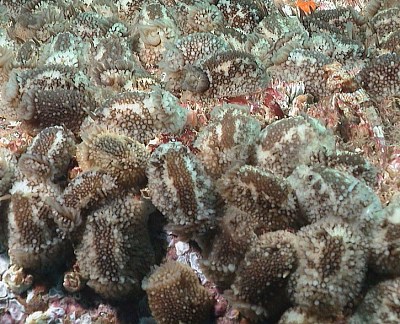
Life span
PHOTO
Aggregation of breeding Onchidoris bilamellata, California. Photo: Clinton Bauder.
Like most aspects of sea slug biology, there is no general rule concerning their life history and life span.
Most species seem to live for about one year, although the tropical Sea Hare Dolabella auricularia can live for six years in an aquarium and the Antarctic cephalaspidean Philine gibba can live for up to four and a half years in nature. On the other hand there are small nudibranchs, especially those that live and feed on short-lived cnidarian colonies which have extremely short life cycles. For example both the European aeolid Tenellia pallida and the coral-eating tropical aeolid Cuthona poritophages can mature in three weeks, and probably die within two or three months. In the case of these very short-lived species, they need to complete their life-cycle before the colony they live and feed on dies. If they are too slow then they will themselves die from starvation before they can breed.
It is also important to realise that many sea slugs have a free-swimming larval stage so that the offspring can escape from their parent's dying colony and find a new one of their own. Have a look at the General Topics Index for information on larvae.
In some cases we can find huge concentration of a single species, either breeding or dying. See the Mass Mortality Page, and many messages concerning Onchidoris bilamellata in Eurpoe and California.
Authorship detailsRudman, W.B., 2004 (July 27) Life span. [In] Sea Slug Forum. Australian Museum, Sydney. Available from http://www.seaslugforum.net/factsheet/lifespan
Related messages
-
What is the life cycle of the sea slug?
From: Jessica, September 24, 2002 -
Nudibranch life-cycle
From: N. Bailey, April 16, 2002 -
Info on the life of a sea slug
From: Randol, April 4, 2002 -
Life Spans
From: Andy Horton , December 22, 1999 -
Question about Slugs
From: Kevin Klein, October 14, 1999
